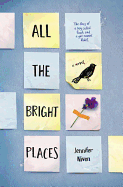
Jennifer Niven's (American Blonde; Ada Blackjack) first YA novel is the story of two teens whose dark paths join to become filled with light and humor. In the opening scene--one of the funniest in literature, for young people or adults--two teens from opposite sides of the social spectrum meet on the roof of their high school, where they've both come to contemplate jumping.
"Take it from me, the worst thing you can do is look down." These are 17-year-old Theodore Finch's first words to former cheerleader Violet Markey. Finch continues, "Come here often? Because this is kind of my spot and I don't remember seeing you here before." Although his friends call him Finch, he's more widely known as "Freak" since eighth grade--reinforced by his outlandish behavior. So everyone naturally assumes that Violet saved Finch from leaping to his death, rather than the reverse. To Violet's credit, she sees "Freak" in a new light after their shared experience, and becomes willing to be seen talking with him in the hallways. She even consents to be Finch's partner in a U.S. geography project called "Wander Indiana."
Niven constructs the project as not only a physical scavenger hunt of Indiana's star attractions but also a literal quest. In alternating chapters narrated by Violet and Finch, each opens up to the other about their pasts. Violet confides in Finch about her survivor's guilt following a car accident that killed her sister, Eleanor, and from which Violet walked away. Finch tells Violet about his father's departure last summer for "the final time" (trading in Finch's family for "a new one he liked better") and the betrayal that led to his nickname. They bring out the best in each other, beginning with lines from Virginia Woolf they share on Facebook.
Together they adhere to their "Rules for Wandering." They take turns choosing the destination; they "take something, leave something" at each spot. First, they explore Hoosier Hill (the highest point in Indiana, at 1,257 feet); Finch takes Violet's hand for the first time, and she feels "a little shock." Next they go to Violet's choice, Bookmobile Park; Violet gets into a car for the first time since her and Eleanor's accident. They travel to Blue Flash, a roller-coaster ride created by grandfatherly John Ivers to give him a rush akin to drag racing ("I love the thrill of impending, weightless doom," Ivers tells them). And on the first warm day of winter, the pair heads to the exquisite Blue Hole in Prairieton, Ind., a three-acre lake on private property. It is both their worst and best day thus far: the worst because Finch stays submerged for so long that Violet fears he's drowned; the best because the cathartic argument that follows when he resurfaces seals their intimate connection.
In many ways, Violet and Finch's lives begin with the novel's opening scene. Finch's presence in Violet's life precipitates her ability to connect with her true self, to tap into her gifts as a writer, and to acknowledge that she needs to move forward from the blog she cowrote with her sister ("[T]here is something about the act of writing that makes me feel as if I'm cheating on her") to create her own platform for collaborating with new writers. Niven subtly draws a parallel between Violet seeing "The Wall" in Finch's bedroom, where he sticks his ideas, thoughts and collected quotes, and the bulletin board in Violet's room where she begins to aggregate categories for an online magazine.
But just as Violet is winding up, Finch begins a downward spiral. Niven captures with precise language how it feels to Finch to battle his wild mood swings. The spaces around him grow and shrink, sounds and colors get too loud. He keeps track of suicide facts and methods (death by jumping, hanging, poison, carbon monoxide), always with humor, often with irony. He can recite the suicide notes of Virginia Woolf, Russian Revolutionary poet Vladimir Mayakovski and Italian poet Cesare Pavese. His contemplations of suicide occur not only at his lowest points, but also at his peaks. Does he savor life's moments more because of his contemplation of its end? Probably. One of the best illustrations of this occurs on his birthday, when he creates for Violet the Jovian-Plutonian gravitational effect, an experience of weightlessness described by Sir Patrick Moore in 1976.
When Finch disappears soon after, his best friends Charlie Donahue and Brenda Shank-Kravitz--and even Finch's mother--assure Violet that this is "normal" behavior for him. But Violet thinks otherwise, and follows the as-yet-unvisited sites on their Wander Indiana map in search of Finch.
In Violet, Finch finds his "Great Manifesto," and through Finch, Violet finds a way back to herself. Teens will devour this funny, smart and insightful love story in one sitting. --Jennifer M. Brown, children's editor, Shelf Awareness

